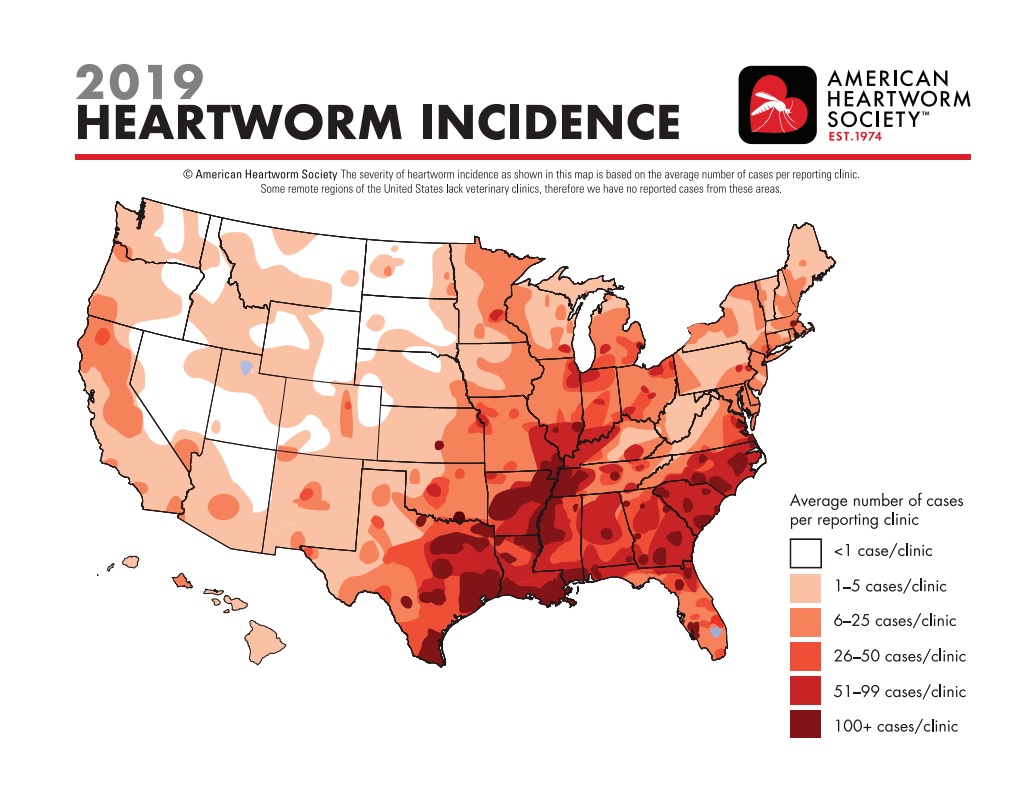
Heartworms 101
Tuesdays with Tony
Good morning, Humans. It’s the first of the month: have your pets had their heartworm prevention?
Did you know that heartworm prevention is less prevention, and more treating the problem before we know it’s there? Let me back up a few steps – sometimes my cat wisdom can get a little quick for the average human mind.
What Is A Heartworm?
Heartworms, otherwise known as Dirofiliara immitis, are a frustrating parasite of dogs and cats that exist in the circulatory system and are spread by mosquitoes. They have been found in every state in the U.S. other than Alaska, and are especially problematic in the southeast. In most areas of the country, heartworm disease can be transmitted year round. Though mosquitoes are less prevalent during cooler months, they can fly indoors and find shelter in warm buildings to keep the lifecycle going.

The Cycle of Doom
Speaking of lifecycle, let’s talk about these annoying little critters and what makes their world go round. Heartworm larvae live in the bloodstream of infected animals, which are then sucked up by a mosquito when they are bitten. While in the mosquitoes’ body, the larvae mature into an infective stage. When that mosquito then bites another susceptible animal, the larvae move into the tissue where they develop for 1-2 months. After that, they move into the bloodstream where they take a few more months to mature into adults and travel into the great vessels of the heart where they live, work, and breed, making baby heartworms to release into the bloodstream to be picked up by another mosquito and infect more animals.
But The Drugs Handle Everything, Right?
Now, the real rub here is this: the heartworm prevention products that we have actually work by killing the developing larvae in the tissue before they turn into adults. These products cannot kill mature larvae or adults.
To make matters worse, we can only detect that a pet has a heartworm infection after the heartworms have reached adulthood, as the antigen we use to detect them is produced by adult female heartworms. So, rather than “preventing” heartworm infection, what we’re really doing is stopping the infection in its tracks while we can, before the nasty parasite gets too big for our medications.
To look for the adult heartworms, we do a blood test that just needs a few drops of blood and generally takes a few minutes to run. Your animals should have that test done every year routinely because of the long period between infection and the ability to detect disease. If we do find a positive test, then we have to pursue heartworm treatment, which is a 3-9 month process that involves expensive injectable medications to kill the adult worms and treat the symptoms of infection. This treatment is only available for dogs, us cats get the short end of the stick as we don’t handle the injectable medication well.
Many dogs and cats are infected with heartworms without showing clinical signs for months or even years, so don’t try to tell me you don’t need to test your dog because they “seem fine.” Listen to your vets’ advice, test your pets yearly, and most importantly, maintain them on heartworm prevention all year round!
I asked about the first of the month at the beginning of this blog because most preventions are given monthly. My humans tend to remember the first of the month to keep them on schedule, and also recommend setting a recurring reminder in the calendar app of your choice.
Heartworm preventions are prescription products (this means you have to bring your pet to the doctor at least once a year to continue getting them) and are generally very safe. Most of them also work to kill intestinal parasites such as hookworms, roundworms, and whipworms, so they have a double effectiveness in keeping all the nasty creepy crawlies away from and out of your pet.
Be Consistent!
The most important point is this: heartworm prevention must be given consistently all year round because if the developing larvae in the tissue gets beyond 1-2 months of age, we cannot prevent the heartworm infection from setting up shop in the heart. When this happens, we don’t know about it until at least 6 months later when we do a routine test. At that point it’s too late for prevention and we need to talk about treatment, which is long, expensive, and not without side effects.

Heartworm Mythbusting
You may have some preconceived notions about heartworms that are probably wrong. So let’s break some of them down.
The first myth I’d like to bust is that cats don’t need to be on heartworm prevention. First off, cats are the most important creature in your house and deserve the best of the best. Cats can most definitely get heartworm disease, but we can’t treat it. We also have a harder time diagnosing heartworm disease in cats because, being the superior species that we are, we often do a good job of killing off female heartworms in our hearts. We don’t do as good with killing the male heartworms, which still cause disease but don’t have the antigen that is tested for. This means false negative tests with cats are not uncommon. The very best thing to do is have your cat on heartworm prevention every month all year for life.
The second myth we should talk about is that if your animal is “indoor only,” they don’t need to be on heartworm prevention. Let’s first hash that term out. Dogs are almost never truly indoor-only. They go out for walks, into a back or front yard, or at least onto a patio. Cats are more frequently inside, however many go on patios, sit by open windows, go into garages, and go outside at least to get from the house to the car when going to the vet. Unless your pet lives in a literal bubble and never sees the light of the sun, they are at risk of being bit by a mosquito in the short sessions of outdoor time they do have. Also, mosquitos do in fact have wings, and can get inside your home quite easily. This means even your truly indoor-only pets are at risk.
The final myth I’ll debunk today is that if you spend part of the year outside the southeast, you don’t need to give heartworm prevention while you’re away. I’ll point you back up to the beginning of the blog where I remind you that the way heartworm preventions work is by killing developing larvae in your pets’ body while they can still be killed, not by preventing them from ever getting there in the first place. Hopefully learning this helps you remember to give your pets heartworm prevention all year round and to make sure to get them tested at the vet every year.
As always, if you have questions, my human staff–*ahem* veterinarians–would be happy to help you find the best products and plan for your furry friends.
Until next week,
~Tony
P.S. Have you subscribed to my blog yet? Don’t rely on Facebook to deliver my incredible cat thoughts to you. Be a good human and scroll down to the purple box and put your email address in there. I promise I won’t spam you, I’ll just send you my blog every Monday. You’re welcome.
Tuesdays with Tony is the official blog of Tony the Clinic Cat at Springhill Equine Veterinary Clinic in Newberry, Florida. If you liked this blog, please subscribe below, and share it with your friends on social media! For more information, please call us at (352) 472-1620, visit our website at SpringhillEquine.com, or follow us on Facebook!
[jetpack_subscription_form title="Subscribe to Whinny's Wisdoms"]

